The X Button
Walk This World
by Todd Ciolek,

As E3 rapidly approaches, rumors spring up about just what might be announced at North America's biggest game-related monument to materialism. For example, last week saw reports that Konami will unveil a 3DS Castlevania with the subtitle Mirror of Fate.
The interesting part? Mirror of Fate is supposedly the work of the same producer and director who brought out 2010's Lords of Shadow, an action game that reimagined the whole Castlevania franchise. All of the Castlevanias for the DS and Game Boy Advance were set within the broader Castlevania canon laid down by Koji Igarashi and Konami's Japanese studios, so it would be notable indeed if Konami took the series further down the path laid by Lords of Shadow.
This pales before the other big rumor that recently arose: a crossover between Star Fox and Metroid for the upcoming Wii U. As the talk about town goes, Retro Studios' Star Fox—Metroid: Fusion Saga will find Metroid's Samus Aran teaming up with the Star Fox animal heroes for both outer-space shooting levels and planetside exploration. It sounds like someone's fan fiction, but it fits with another rumor about Retro taking on the next Star Fox. After Metroid: Other M's storyline, pairing Samus with a fox-headed space pilot might be a welcome dose of dignity.
NEWS
E.X. TROOPERS IS LOST PLANET'S SHADED SCHOOLYARD SHOOTER SPIN-OFF
E.X. Troopers technically isn't a new Capcom venture. It's set in the same universe as Lost Planet, and it has the same general motivations of shooting enormous bugs and riding armored robots. Yet E.X. Troopers sure looks different. A 3DS and PlayStation 3 title, it portrays a mostly teenage cast of soldiers in a cel-shaded, comic-book style that's much shinier than anything Lost Planet had to show.
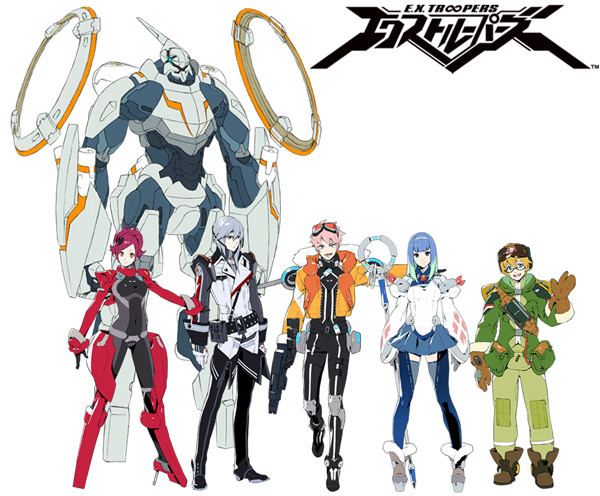
Set on the world of EDN-3rd, E.X. Troopers follows a band of young hunters who apparently get high-school credits by tracking down Akrid creatures and pirates. The cast checks off every necessary cliché, from brash main character Bren to the nature lover TeeKee and the cheerful pilot Julie Fliesher (who might be in love with our hero!). The gameplay also sports the two main modes that Lost Planet popularized. The men and women of E.X. Troopers can trudge around with rifles and jetpacks, or they can hop into towering “Vitality Suit” mecha. To push things further into anime-tailored parts, the game gives Bren's Suit an AI personality.
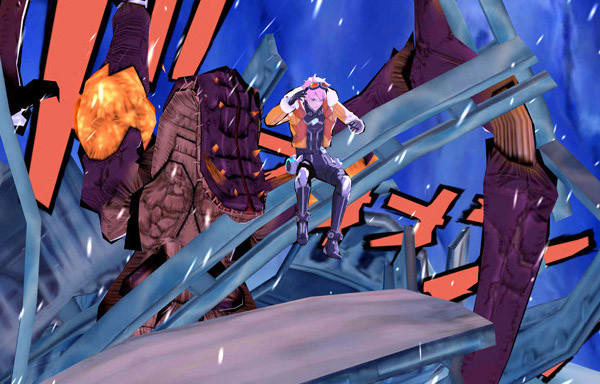
Contrary to initial speculation, E.X. Troopers isn't a salvaged version of Mega Man Legends 3, which Capcom so cruelly canceled last year. And while the remains of Legends 3 gather dust, E.X. Troopers heads for a release on both the 3DS and PS3 in Japan this year. An American launch is likely planned.
INAFUNE SEES SORCERY, SWORDS, SPINES IN SONY'S SOUL SACRIFICE
Many eyes followed Keiji Inafune when he left Capcom in 2010. What would he do on his own, this man who helmed Capcom hits from Mega Man up through Dead Rising? In the past year, Inafune's founded the dual studios of Comcept and Intercept, dabbled in mobile games, and appeared as a special attack in the Neptunia series (see below). He's also announced two titles. The first is Kaio: King of Pirates, a 3DS action game full of animal warriors. The second is Soul Sacrifice, a multiplayer Vita offering in development at Marvelous AQL and Sony's Japan Studio.
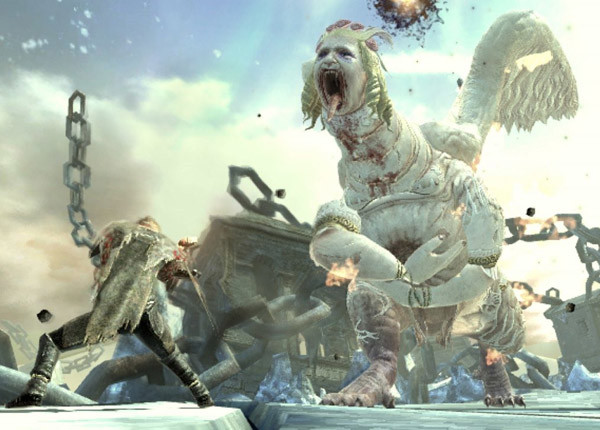
Soul Sacrifice explores a fantasy realm of dusty battlefields, towering monstrosities…and blatant body horror. It's superficially similar to the territory staked out by games like Knights Contract, but Soul Sacrifice delves further into uncomfortable depths. For one thing, the player's customized character creates weapons from his or her own organs: the trailer shows a mage yanking out his spine through his own mouth and fashioning an “Excalibur” sword from it. Everything in the game comes at a gruesome cost, as warriors and sorcerers give up either body parts or valuable items to forge their abilities. The horrific beasts they battle are actually humans corrupted by magic, and the allegedly heroic characters risk the same fate with their sacrificial incantations.
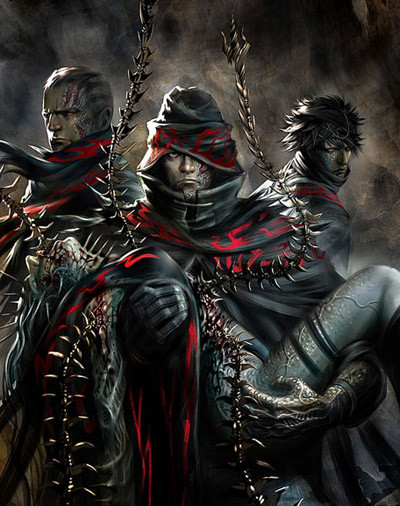
There's also a price to pay in the game's online quests, where four-player parties are often required to make unpleasant choices in battle. Some party members might deliberately harm themselves to pull off damaging attacks, and players can argue over what to do with a freshly killed creature's remains. All of this strongly hints that Inafune had a worldwide market in mind for the game, but Sony's only announced a “winter” Japanese release for the moment.
NEPTUNA V TRAVELS TIME AND SPACE, STILL HAS CONSOLE HEROINES
One can see Compile Heart's Neptunia games as battlegrounds between devoted old-school geekery and the excesses of the modern era. On the one hand, it's set in a fantasy realm that represents the entire game industry, where personified consoles and companies chat like RPG characters and folks like Keiji Inafune and Takahashi “Master Higgins” Meijin drop by. On the other hand, this allegory is told through anime heroines who change from little girls into revealingly clad cyber-goddesses, and past Neptunia games exploited this on every possible stage. The war rages anew with Hyperdimension Neptunia V, a PlayStation 3 RPG set in the nostalgic gaming refuge of 1989.
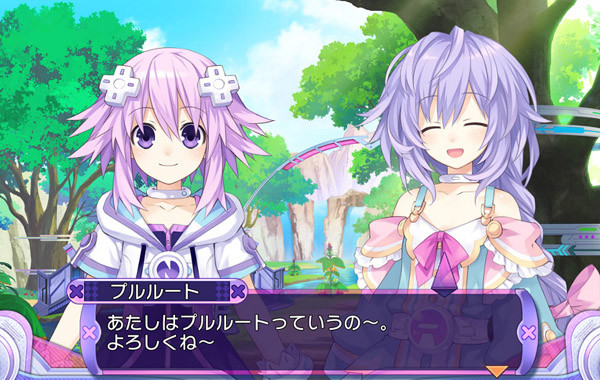
The game finds Neptune, the Sega-coded lead of the original game, journeying back to the twilight of the 1980s. There she finds her comrades caught up in the struggles of the age: the Nintendo nation and its patron goddess try to conquer all others, the Sony goddess isn't an independent power yet, and the Sega-like land of Planeptune is just a fledgling country. A greater threat lies in the lineup of seven villains, ranging from the software-pirating witch Arfoire to a middle-aged corporate suit named Akudaijin. A new playable goddess also emerges in the form of Iris Heart, who transforms from an exuberant grade-schooler to a vicious techno-dominatrix. Yes, this is once again that sort of game.
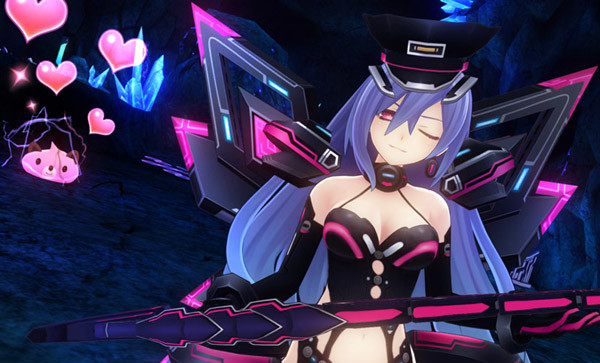
For those who prefer their pandering in the form of game-industry cameos, Neptunia V brings back Keiji Inafune in the form of a Yamato-like battleship that can be summoned in battle. Esteemed composer Nobuo Uematsu (Final Fantasy, The Last Story) also appears with his Earthbound Papas band. Neptunia V's out in Japan at the end of August, and NIS America will likely have an American version shortly afterward.
MIGHTY SWITCH FORCE NOW SLIGHTLY LONGER
Do you have a 3DS? Did you buy Mighty Switch Force? Well, you should. For one thing, it's a cheap, downloadable puzzle-platformer from Wayforward, the same developer that made the Shantae games. It arranges levels like treasure hunts, with officer Patricia Wagon using her block-moving ability to track down a gang of escaped (but stationary) felons. It's an inventive game that shows of Wayforward's excellent small-screen sprite artistry, and it has only one real problem: there isn't more of it.
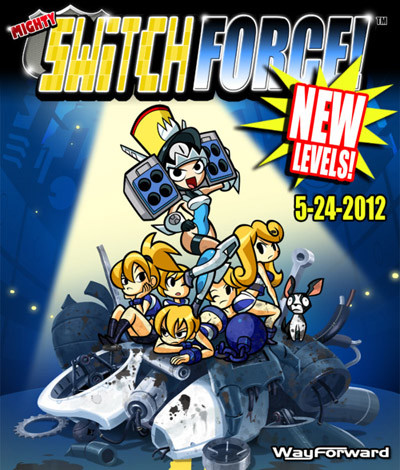
Well, Wayforward addressed that with a free expansion for Mighty Switch Force. It only adds five more levels, but it also enhances the game's 3-D effect and offers a quick “retry” option for nutcases trying to perfect their playtime in each stage. It's out tomorrow.
DOWNLOAD ROUNDUP: SEGA VINTAGE COLLECTIONS
Let's set aside the modern era for a moment. Sega certainly is. In the coming two weeks, they're releasing four different Sega Vintage Collections, and each includes three titles from Sega's glory days. Yes, classic games are regularly repackaged and served in downloadable form, but this recent influx from Sega makes for an interesting stretch of history. It's the Sega that fans remember, the company that bumped Nintendo off its perch and dominated half the game industry in the early 1990s.
First, a quick note about pricing. A number of the games in these bundles are already available on the Wii's Virtual Console, and a few were also released individually on Xbox Live. However, all of them are cheaper if you just get Live's ten-dollar bundles or the PlayStation Network's individual downloads. These Vintage Collections also come with elaborate menus that offer sound tests and simulate decorated game rooms. And there's one game that was never properly available in North America before this month.
ALEX KIDD & CO.
Vintages: 1986, 1987, 1989
Platform: Xbox Live, PlayStation Network
Available: May 23
MSRP: 800 Points (Live), $5.00 per game (PSN)
The “and company” part of the title highlights the truth about this collection. Instead of compiling a series, it's just a thrown-together mix of Alex Kidd in Miracle World, Revenge of Shinobi, and Super Hang-On. That's a bit odd, since Alex Kidd and Shinobi spawned franchises of their own. Still, it's a look at Sega's creations across different hardware: the doomed Sega Master System, the wildly successful Genesis, and the once-proud domain of arcades.
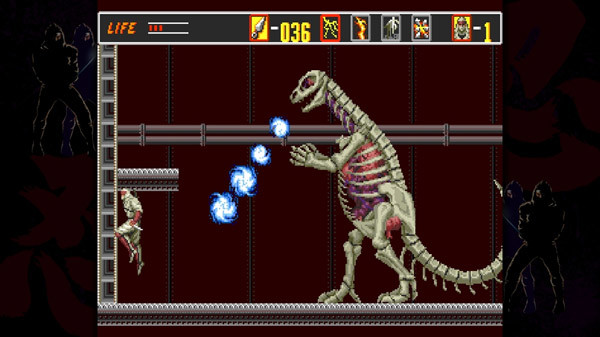
For the kids who owned the Sega Master System, Alex Kidd in Miracle World was their response to Nintendo's endlessly popularized Mario games. Alex, a monkey-like master of fisticuffs, was never as successful as his successor Sonic the Hedgehog, but his game had motorcycles, janken matches, and…well, somewhat loose control. Revenge of Shinobi (above) arrived in more profitable times, hitting the Sega Genesis just as the system was taking off. It's a solid platformer despite its initially stiff feel—and despite at least two Shinobi sequels that improve upon it. Funny how those aren't part of the collection.
Super Hang-On has the lowest profile of any title in this Vintage Collection, though it and the original Hang-On were notable for their motorcycle-seat cabinets when they first hit arcades. The Sega Vintage Collection can't replicate that (except in the game's menus), of course, and Super Hang-On's certainly not as immediately familiar as Sega's Outrun.
Worth it? Eh. Revenge of Shinobi holds up well enough, but the other two games are history lessons and not much more.
MONSTER WORLD
Vintages: 1987, 1992, 1994
Platform: Xbox Live, PlayStation Network, Wii
Available: May 23 (Live, PSN), Right Now (Wii)
MSRP: 800 Points (Live), $5.00 per game (PSN), Various (Wii)
The nomenclature of the Monster World series is odd and inextricably linked with the Wonder Boy titles. The original Wonder Boy was a jungle-themed platformer created by Sega and Westone, the latter of whom then let Hudson Soft turn the game into Adventure Island. Meanwhile, Sega had Westone continue the series with Wonder Boy in Monster Land. This began the Monster World franchise, and Sega's Vintage Collection features Wonder Boy in Monster Land, Wonder Boy in Monster World, and Monster World IV. Absent are the first Wonder Boy, the shooter-like Monster Lair, and the highly praised Wonder Boy III: The Dragon's Trap. Sounds like there's another collection in the making.
In spite of the absences, these three pieces of Monster World come recommended. They're not the most complex games of their day, but they're charming, challenging creations from an underrated developer. Wonder Boy in Monster Land, presented in its arcade form, is a decent platformer that sports such basic RPG features as shops, armor, and weapon upgrades. That was all impressive back in 1987. Wonder Boy in Monster World (a.k.a. The Dynastic Hero) is an improved Genesis follow-up, with expanded gameplay and more touches of personality.
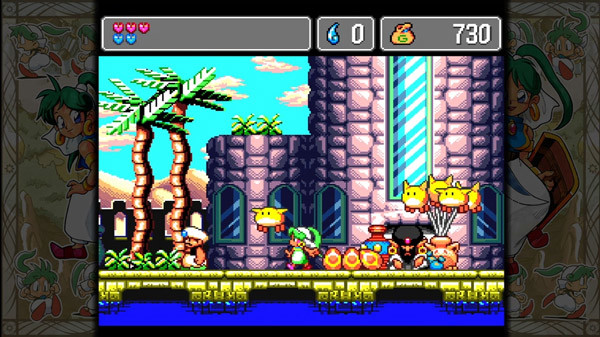
Then there's Monster World IV (above). It's the only game in the series that's technically not also a Wonder Boy title, and it's the only one that wasn't previously translated into English. It's also the best part of this whole Vintage Collection thing. The game mixes side-scrolling play and action-RPG elements as ably as its predecessors, but it's more of an Arabian fantasy than a vaguely medieval affair. And with that change comes a heroine named Asha, her hovering pet Pepelogoo, a sarcastic genie, and a cast of colorful townsfolk. Pepe carries Asha through the skies, Asha struggles to lift an overfed Pepe, and the two of them cooperate in all sorts of endearing ways as they trudge through dungeons. It finds Westone at the top of their craft, and it's reason enough to mourn their transformation into Westone Bit Entertainment, makers of absolutely nothing interesting.
Worth it? Yes. A translated Monster World IV would merit purchase on its own, and it's even better as a package deal.
GOLDEN AXE
Vintages: 1989, 1991, 1993
Platform: Xbox Live
Available: May 30
MSRP: 800 Points
Golden Axe is often underrated when it comes to Sega's history. Double Dragon and Final Fight established the whole idea of an arcade brawler full of street punks, but Golden Axe took that idea to a grim fantasy stage ripped from Conan the Barbarian and Red Sonja. It was a world where dwarf barbarians and bikini-clad warriors (men and women) rode fire-breathing dragons and kicked magic-stealing munchkins across the screen. It was quite the sight when it hit arcades in 1989, and it drew just as much attention when a convincing replica hit the Sega Genesis.
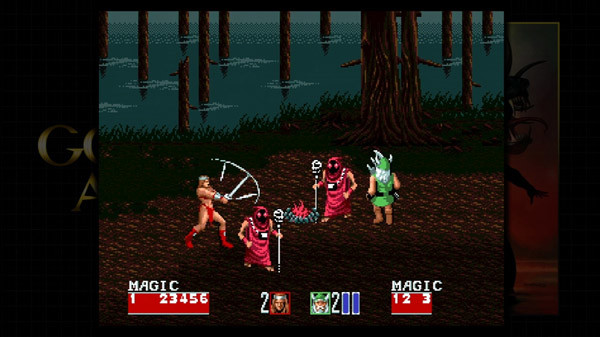
It's fitting that the arcade version of Golden Axe headlines this package. The game shows the same repetition that dogs nearly all arcade brawlers, but the controllable creatures and changing terrain make it surprisingly diverse. Golden Axe II (above) isn't so much a bad game as it is a missed opportunity. It was created for the Genesis, but the developers added little depth to what's essentially a retread of the first Golden Axe. The series dipped lower with Golden Axe III, another Genesis follow-up that merely went through the motions. It was never released at retail in North America, but Sega's since dragged it out for Nintendo's Virtual Console and various compilations.
It's disappointing that Sega stuck to the numbered Golden Axe games for this collection, ignoring more interesting titles lurking in the margins. The most regrettable absence is that of Golden Axe: The Revenge of Death Adder, a 1992 arcade game that offered branching paths and four-player cooperation. It's widely considered the real Golden Axe sequel, and it never found its way out of the arcades. Other Golden Axe spin-offs, including the action-RPG Golden Axe Warrior and the fighting game The Duel, aren't as notable, though they'd be better company than two unremarkable Genesis retreads.
Worth it? Not quite. Only the first game's worth the trip.
STREETS OF RAGE
Vintages: 1991, 1992, 1994
Platform: Xbox Live
Available: May 30
MSRP: 800 Points
If Golden Axe was Sega's unrepentant tribute to '80s sword-and-sandal camp, Streets of Rage took its cues from The Warriors, Streets of Fire, and any other movie wherein a gaggle of street thugs terrorizes a city. In a sign of the changing times, the original Streets of Rage skipped brawler-friendly arcades and went straight to the Sega Genesis (and then the Game Gear and Master System, but no one noticed the latter). After two sequels, Streets of Rage was never seen again. Well, Core's Fighting Force was intended as a Streets of Rage sequel, but it's for the best that Sega pulled the license.
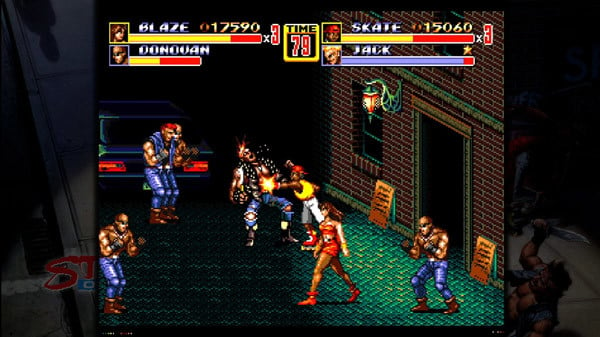
You won't find Fighting Force in this Streets of Rage collection, but you'll find some perfect examples of the “beat 'em up” genre that took up a good section of the 16-bit game industry. The original Streets of Rage remains an enjoyable brawler with an excellent soundtrack, and Streets of Rage 2 (above) improves just about everything, music included. The games also do their best to break up the monotony inherent to such game design, changing scenery and adding various obstacles. That doesn't always work.
Streets of Rage 3 is an odd finale for the series. In gameplay and visual quality, it's arguably the high point. Yet many fans remember it for its odd, almost experimental soundtrack and some rather invasive censorship. In 1994 Sega of America had no choice but to remove a comically flamboyant boss named Ash, but less necessary were changes to the game's storyline and a strange “gender neutral” recoloring of the characters. It's not clear if the Vintage Collection's version of the game will be uncensored or not.
Worth it? All three games are quite similar, but this still beats the Golden Axe bundle.
NEXT WEEK'S RELEASE
ATELIER MERURU: THE APPRENTICE OF ARLAND 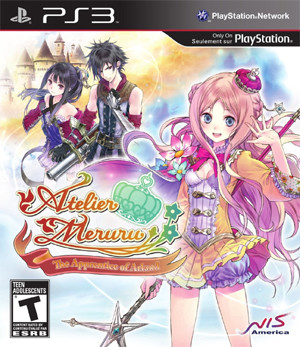 Developer: Gust
Developer: Gust Publisher: NIS America Platform: PlayStation 3 Players: 1 MSRP: $49.99/$64.99 (Special Edition) Atelier Meruru is an ending of sorts. It's not the end of the Ateliler series itself, mind you. No, Atelier games will likely be made until Gust goes bankrupt or an overheated Sun swallows the world. However, Atelier Meruru closes the Arland trilogy, which also includes Atelier Rorona and Atelier Totori. Like its two predecessors, Meruru is an RPG with an eye for crafting useful things. All of the major characters are alchemists, though the latest heroine, Meruru, is technically still in training. As the princess of the insular kingdom of Arls, she adopts alchemical studies under the partly voluntary guidance of Totori, main character of a certain previous game in the series. In their wanderings, they encounter knights, adventurers, maids, aristocrats, and two unnerving homunculus children. Also on hand is prior protagonist Rorona, who was turned into a child by a potion and a niche-RPG industry that demands small girls in all products. Meruru's kingdom-building quest figures into the game's setting, as new areas crop up with her latest discoveries. Exploring those areas leads to RPG scenery full of turn-based battles, glittering special attacks, and enemies that players can see well ahead of time (now standard on most RPG models). Naturally, there's also an elaborate lineup of ingredients for the alchemists to mix, creating all sorts of items for combat use. Special mention must be made of the game's look, as Atelier Meruru's character models mimic anime to very convincing effect. The rest of the scenery isn't half as impressive, but these games do tend to be mostly about the characters, don't they?
|
discuss this in the forum (31 posts) |
this article has been modified since it was originally posted; see change history